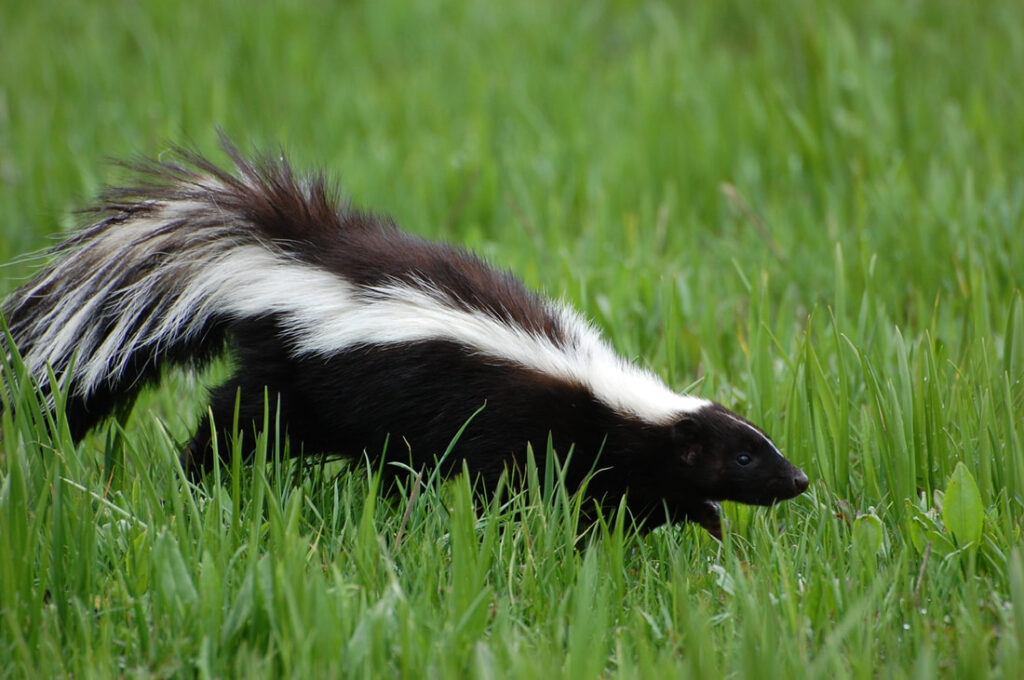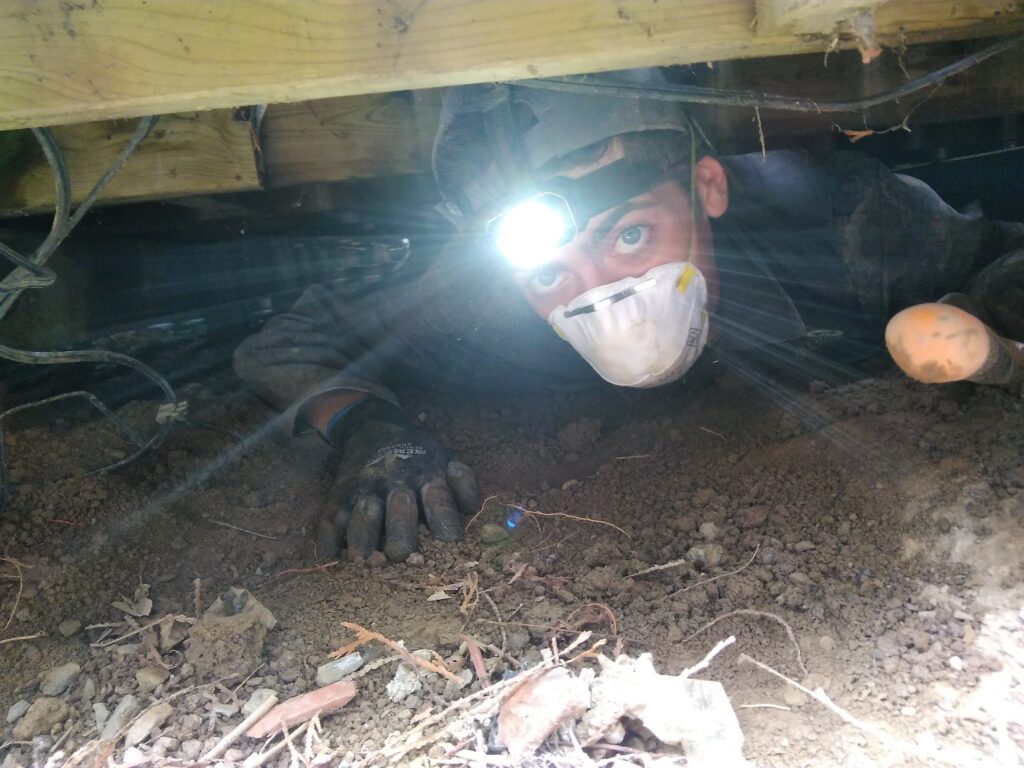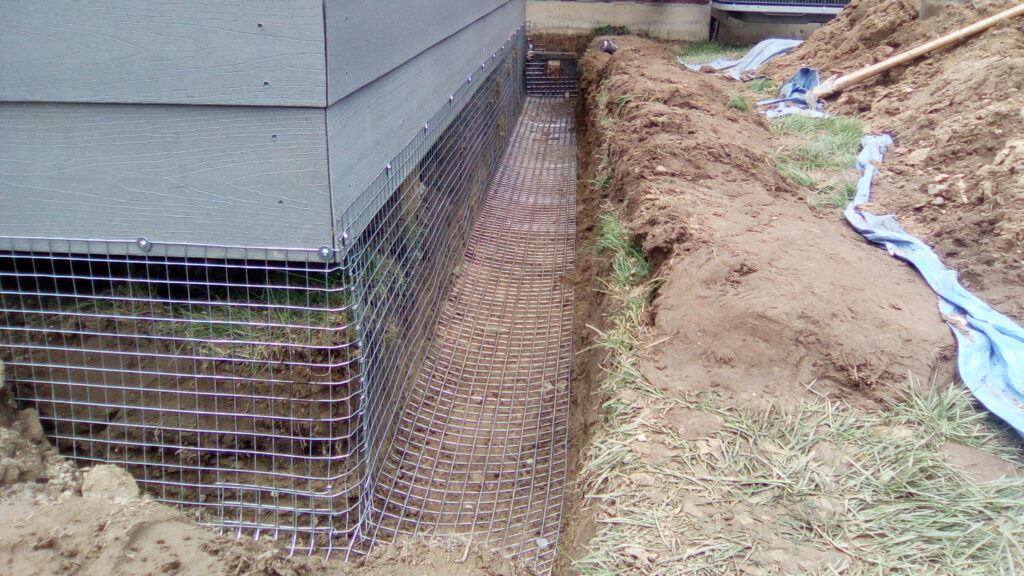What Are the Physical Characteristics of the Striped Skunk?
 Most people can easily identify striped skunks by their distinct physical characteristics. Skunks have a pure black coat and two thick white stripes situated along the back and the tail. Stripe patterns vary widely, but most animals have a stripe running from the forehead to the snout.
Males have a larger body mass than females. The largest animals can weigh up to 13 pounds, while the smaller ones can be as small as two pounds. Striped skunks lose a significant amount of weight in the winter, typically as much as 45% of their total body weight. The reduction in body mass is attributed to hibernation-like behaviors. The striped skunk enters a state of torpor during the colder months, only leaving their dens occasionally and feeding rarely.
Most people can easily identify striped skunks by their distinct physical characteristics. Skunks have a pure black coat and two thick white stripes situated along the back and the tail. Stripe patterns vary widely, but most animals have a stripe running from the forehead to the snout.
Males have a larger body mass than females. The largest animals can weigh up to 13 pounds, while the smaller ones can be as small as two pounds. Striped skunks lose a significant amount of weight in the winter, typically as much as 45% of their total body weight. The reduction in body mass is attributed to hibernation-like behaviors. The striped skunk enters a state of torpor during the colder months, only leaving their dens occasionally and feeding rarely.
Where Do Striped Skunks Live?
Striped skunks are generally solitary creatures. Females and occasionally males may form communal dens in the winter, and a mother skunk lives with her offspring until fall when the family disperses in search of individual shelters. They do not often show aggression unless provoked. Skunks generally do not construct their own homes. Instead, they nest in burrows abandoned by animals — such as foxes and other small mammals — or dig their way under previously existing structures. Skunks also live in or near logs or brush piles. They search for underground nests in the winter. Skunk denning habits change with the season. During the warmer months, they move dens every few days, seeking secluded and dark locations with easy access to food and water. In the winter, they stay in one place, rarely leaving their dens. Though the striped skunk doesn’t usually return to previous shelters, it may come back to its winter home in the future. Females also stay in a single den while raising their little ones, and their offspring may return to their birthing site when seeking a place of their own.
Striped skunks will not hesitate to take up residence in your backyard if they see an opportunity. They tend to prefer yards with plenty of thick foliage and underbrush. Skunks don’t often seek refuge in Milwaukee yards that do not have many hiding places. The most prominent sign of skunk presence is their odor. You can’t miss it if a skunk sprays near your home, but you may also notice a particularly musky smell near a den. You may also see small holes in your yard or freshly dug dirt under decks, sheds, or other structures.
Skunk denning habits change with the season. During the warmer months, they move dens every few days, seeking secluded and dark locations with easy access to food and water. In the winter, they stay in one place, rarely leaving their dens. Though the striped skunk doesn’t usually return to previous shelters, it may come back to its winter home in the future. Females also stay in a single den while raising their little ones, and their offspring may return to their birthing site when seeking a place of their own.
Striped skunks will not hesitate to take up residence in your backyard if they see an opportunity. They tend to prefer yards with plenty of thick foliage and underbrush. Skunks don’t often seek refuge in Milwaukee yards that do not have many hiding places. The most prominent sign of skunk presence is their odor. You can’t miss it if a skunk sprays near your home, but you may also notice a particularly musky smell near a den. You may also see small holes in your yard or freshly dug dirt under decks, sheds, or other structures.
When Is the Striped Skunk Mating Season?
Male skunks crawl out of their warm winter dens in search of mates in mid-February. Males interested in the same mate turn aggressive, fighting each other and frequently spraying in the process. Female skunks aren’t always willing partners. When a persistent male doesn’t leave her alone, the female uses her spray to give a clear signal that she is not interested. If a pair successfully mate, the male moves on in search of the next willing female. The expectant mother abandons her winter den for a more suitable place to bring her kits into the world. Mating season in Wisconsin lasts until mid-March. The season’s kits are born in April and May. While you may not notice a striped skunk den during the winter season, it’s hard to miss its presence during mating season or after kits are born. Taking steps to prevent skunks from establishing dens on your property reduces the chances of an aggressive skunk encounter, whether from agitated males or protective mothers. It can also keep you from experiencing the unpleasant and long-lasting skunk odor in or around your home.What Do Skunks Eat?
Skunks are opportunistic feeders with a varied, omnivorous diet, which changes from season to season. In the spring and summer months, they primarily consume insects, including bees, crickets, beetles, and grasshoppers. They also consume fruit, plants, worms, eggs, and small reptiles. In the winter, they spend most of their time hibernating and do not eat often. When they venture out, they eat small mammals, reptiles, and fish. A striped skunk seldom feeds on vegetation in the winter, partly due to lack of availability.What About Skunk Spray?
Skunks are known for their highly potent, unappealing spray. Skunks have glands underneath their tails that produce an oily liquid that is a mixture of sulfur-containing chemicals. It is the sulfur that emits the offensive odor. The primary purpose of skunk spray is to warn and ward off potential predators. Striped skunks can employ their spray within seconds. One of the most interesting striped skunk facts is that the mist from their spray can travel up to 10 to 20 feet! When it sprays, you can smell it 3.5 miles away. Skunks rarely spray humans unless provoked. Never attempt to remove wildlife or approach a striped skunk. While these creatures are typically docile, they are wild animals and can act unpredictably. If a skunk sprays you, do not panic. Your health is not in danger, but the smell is very uncomfortable. It can take several days for the odor to fade away; however, certain mixtures such as hydrogen peroxide and dish soap can neutralize the smell.What Wildlife Removal Services Does Skedaddle Provide?
 Skedaddle takes care of all your skunk removal needs, from assessment to exclusion. When our technicians arrive on a property where the owners suspect a skunk residence, they perform a thorough assessment. Skedaddle technicians understand striped skunk behavior and have the training and experience to identify dens. Once found, they determine whether there is a current occupant and whether kits are present.
Removing skunks is a delicate process, especially if there are kits. We don’t recommend removing skunk families when kits are at their most vulnerable. When it’s safe to proceed, our technicians utilize a special hands-on removal technique that keeps the skunk safe during removal and doesn’t result in spraying. When there are little ones, the technicians place them inside a heated baby box, allowing the mother to access and relocate her offspring safely.
After the striped skunk is out of the den, we clean and clear any contaminated materials that may pose a health risk to you and your family. We then perform exclusion techniques, sealing the opening to the current den and installing a heavy-gauge screen to block off other potential entry points. As a final measure, we utilize a safe deodorizer in the surrounding area that deters skunks from wandering onto your property.
Skedaddle takes care of all your skunk removal needs, from assessment to exclusion. When our technicians arrive on a property where the owners suspect a skunk residence, they perform a thorough assessment. Skedaddle technicians understand striped skunk behavior and have the training and experience to identify dens. Once found, they determine whether there is a current occupant and whether kits are present.
Removing skunks is a delicate process, especially if there are kits. We don’t recommend removing skunk families when kits are at their most vulnerable. When it’s safe to proceed, our technicians utilize a special hands-on removal technique that keeps the skunk safe during removal and doesn’t result in spraying. When there are little ones, the technicians place them inside a heated baby box, allowing the mother to access and relocate her offspring safely.
After the striped skunk is out of the den, we clean and clear any contaminated materials that may pose a health risk to you and your family. We then perform exclusion techniques, sealing the opening to the current den and installing a heavy-gauge screen to block off other potential entry points. As a final measure, we utilize a safe deodorizer in the surrounding area that deters skunks from wandering onto your property.



